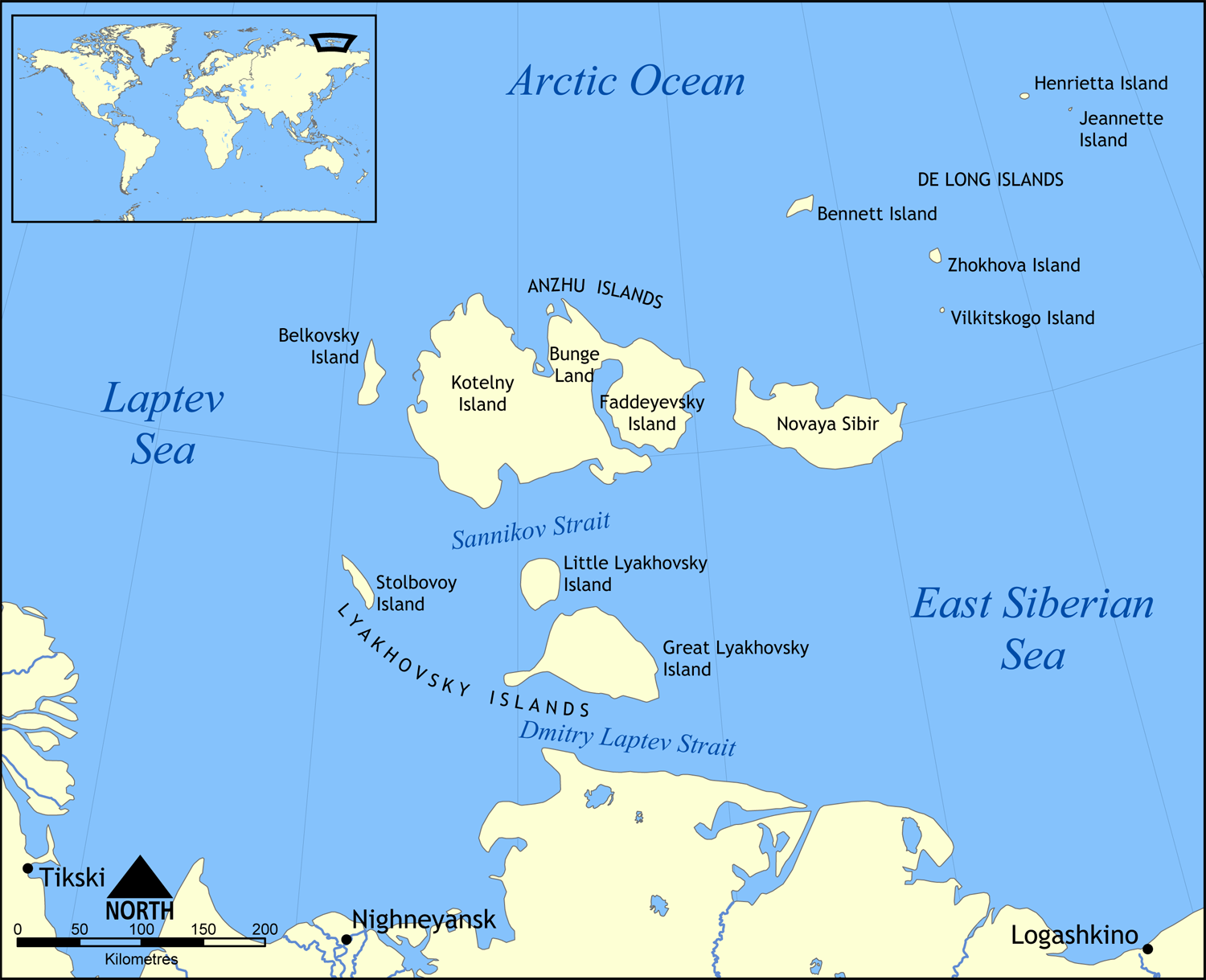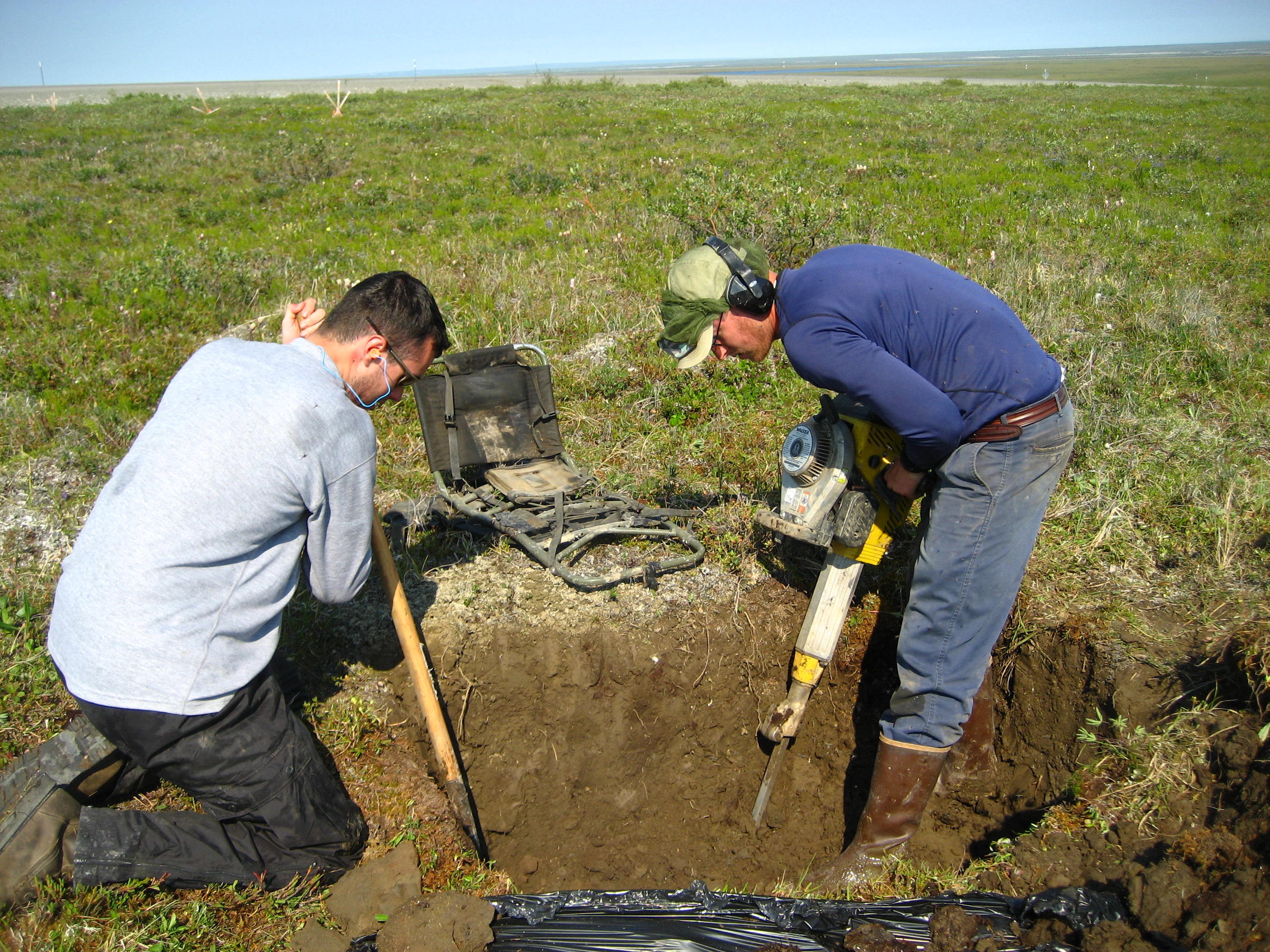|
Little Lyakhovsky Island
Maly Lyakhovsky Island () is the second largest of the Lyakhovsky Islands belonging to the New Siberian Islands archipelago in Laptev Sea in northern Russia. It has an area of . The Lyakhovsky Islands are named in honour of Ivan Lyakhov, who explored them in 1773. Geology Maly Lyakhovsky Island consists of Upper Jurassic to lower Cretaceous turbidites, also known as ''flysch'', covered by a thin veneer of Pliocene to Pleistocene sediments. These Mesozoic rocks consist of sandstones, argillites, and shales deformed into east-northeast striking folds about wide. The Mesozoic rocks are covered by a relatively thin layer of Pliocene to Pleistocene sandy and clayey sediments of colluvial and alluvial origin. Near the coast, the alluvial sediments grade into nearshore marine sediments containing fossil marine mollusks and lignitized wood. Thick permafrost characterized by massive ice wedges has developed in these sediments.Fujita, K., and D.B. Cook, 1990, ''The Arctic continental ... [...More Info...] [...Related Items...] OR: [Wikipedia] [Google] [Baidu] |
New Siberian Islands Map
New or NEW may refer to: Music * New, singer of K-pop group The Boyz * ''New'' (album), by Paul McCartney, 2013 ** "New" (Paul McCartney song), 2013 * ''New'' (EP), by Regurgitator, 1995 * "New" (Daya song), 2017 * "New" (No Doubt song), 1999 * "new", a song by Loona from the 2017 single album '' Yves'' * "The New", a song by Interpol from the 2002 album ''Turn On the Bright Lights'' Transportation * Lakefront Airport, New Orleans, U.S., IATA airport code NEW * Newcraighall railway station, Scotland, station code NEW Other uses * ''New'' (film), a 2004 Tamil movie * New (surname), an English family name * NEW (TV station), in Australia * new and delete (C++), in the computer programming language * Net economic welfare, a proposed macroeconomic indicator * Net explosive weight, also known as net explosive quantity * Network of enlightened Women, an American organization * Newar language, ISO 639-2/3 language code new * Next Entertainment World, a South Korean media company ... [...More Info...] [...Related Items...] OR: [Wikipedia] [Google] [Baidu] |
Sandstone
Sandstone is a Clastic rock#Sedimentary clastic rocks, clastic sedimentary rock composed mainly of grain size, sand-sized (0.0625 to 2 mm) silicate mineral, silicate grains, Cementation (geology), cemented together by another mineral. Sandstones comprise about 20–25% of all sedimentary rocks. Most sandstone is composed of quartz or feldspar, because they are the most resistant minerals to the weathering processes at the Earth's surface. Like uncemented sand, sandstone may be imparted any color by impurities within the minerals, but the most common colors are tan, brown, yellow, red, grey, pink, white, and black. Because sandstone beds can form highly visible cliffs and other topography, topographic features, certain colors of sandstone have become strongly identified with certain regions, such as the red rock deserts of Arches National Park and other areas of the Southwestern United States, American Southwest. Rock formations composed of sandstone usually allow the p ... [...More Info...] [...Related Items...] OR: [Wikipedia] [Google] [Baidu] |
Sakha Republic
Sakha, officially the Republic of Sakha (Yakutia), is a republics of Russia, republic of Russia, and the largest federal subject of Russia by area. It is located in the Russian Far East, along the Arctic Ocean, with a population of one million. Sakha comprises half of the area of its governing Far Eastern Federal District, and is the world's List of country subdivisions by area, largest country subdivision, covering over 3,083,523 square kilometers (1,190,555 sq mi). ''Sakha'' following regular sound changes in the course of development of the Yakut language) as the Evenk and Yukaghir exonyms for the Yakuts. It is pronounced as ''Haka'' by the Dolgans, Dolgan language, whose language is a close relative of the Yakut language.Victor P. Krivonogov, "The Dolgans’Ethnic Identity and Language Processes." ''Journal of Siberian Federal University'', Humanities & Social Sciences 6 (2013 6) 870–888. Geography * ''Borders'': ** ''internal'': Chukotka Autonomous Okrug (660 km) ( ... [...More Info...] [...Related Items...] OR: [Wikipedia] [Google] [Baidu] |
Yakutsk
Yakutsk ( ) is the capital and largest city of Sakha, Russia, located about south of the Arctic Circle. Fueled by the mining industry, Yakutsk has become one of Russia's most rapidly growing regional cities, with a population of 355,443 at the 2021 census. Yakutsk has an average annual temperature of , winter high temperatures consistently well below , and a record low of has been recorded.Погода в Якутске. Температура воздуха и осадки. Июль 2001 г. (in Russian) As a result, Yakutsk is the coldest ''major city'' in the world (although a number of smaller towns in that region are slightly colder). Yakutsk is also the largest city located in [...More Info...] [...Related Items...] OR: [Wikipedia] [Google] [Baidu] |
Marine And Petroleum Geology
''Marine and Petroleum Geology'' is a peer-reviewed scientific journal covering marine and petroleum geology. It was established in 1984 and is published by Elsevier. The editor-in-chief is Massimo Zecchin ( Istituto Nazionale di Oceanografia e di Geofisica Sperimentale) and (Max) Qinhong Hu (The University of Texas at Arlington). Abstracting and indexing The journal is abstracted and indexed in: According to the ''Journal Citation Reports'', the journal has a 2017 impact factor The impact factor (IF) or journal impact factor (JIF) of an academic journal is a type of journal ranking. Journals with higher impact factor values are considered more prestigious or important within their field. The Impact Factor of a journa ... of 3.281. References External links * Geology journals English-language journals Marine geology Petroleum geology journals Bimonthly journals Elsevier academic journals Academic journals established in 1984 {{Geology-journal-stub ... [...More Info...] [...Related Items...] OR: [Wikipedia] [Google] [Baidu] |
Permafrost
Permafrost () is soil or underwater sediment which continuously remains below for two years or more; the oldest permafrost has been continuously frozen for around 700,000 years. Whilst the shallowest permafrost has a vertical extent of below a meter (3 ft), the deepest is greater than . Similarly, the area of individual permafrost zones may be limited to narrow mountain summits or extend across vast Arctic regions. The ground beneath glaciers and ice sheets is not usually defined as permafrost, so on land, permafrost is generally located beneath a so-called active layer of soil which freezes and thaws depending on the season. Around 15% of the Northern Hemisphere or 11% of the global surface is underlain by permafrost, covering a total area of around . This includes large areas of Alaska, Canada, Greenland, and Siberia. It is also located in high mountain regions, with the Tibetan Plateau being a prominent example. Only a minority of permafrost exists in the Southern Hemi ... [...More Info...] [...Related Items...] OR: [Wikipedia] [Google] [Baidu] |
Mollusk
Mollusca is a phylum of protostomic invertebrate animals, whose members are known as molluscs or mollusks (). Around 76,000 extant species of molluscs are recognized, making it the second-largest animal phylum after Arthropoda. The number of additional fossil species is estimated between 60,000 and 100,000, and the proportion of undescribed species is very high. Many taxa remain poorly studied. Molluscs are the largest marine phylum, comprising about 23% of all the named marine organisms. They are highly diverse, not just in size and anatomical structure, but also in behaviour and habitat, as numerous groups are freshwater and even terrestrial species. The phylum is typically divided into 7 or 8 taxonomic classes, of which two are entirely extinct. Cephalopod molluscs, such as squid, cuttlefish, and octopuses, are among the most neurologically advanced of all invertebrates—and either the giant squid or the colossal squid is the largest known extant i ... [...More Info...] [...Related Items...] OR: [Wikipedia] [Google] [Baidu] |
Fossil
A fossil (from Classical Latin , ) is any preserved remains, impression, or trace of any once-living thing from a past geological age. Examples include bones, shells, exoskeletons, stone imprints of animals or microbes, objects preserved in amber, hair, petrified wood and DNA remnants. The totality of fossils is known as the ''fossil record''. Though the fossil record is incomplete, numerous studies have demonstrated that there is enough information available to give a good understanding of the pattern of diversification of life on Earth. In addition, the record can predict and fill gaps such as the discovery of '' Tiktaalik'' in the arctic of Canada. Paleontology includes the study of fossils: their age, method of formation, and evolutionary significance. Specimens are sometimes considered to be fossils if they are over 10,000 years old. The oldest fossils are around 3.48 billion years to 4.1 billion years old. Early edition, published online before prin ... [...More Info...] [...Related Items...] OR: [Wikipedia] [Google] [Baidu] |
Marine (ocean)
The ocean is the body of salt water that covers approximately 70.8% of Earth. The ocean is conventionally divided into large bodies of water, which are also referred to as ''oceans'' (the Pacific, Atlantic, Indian, Antarctic/Southern, and Arctic Ocean),"Ocean." ''Merriam-Webster.com Dictionary'', Merriam-Webster, https://www.merriam-webster.com/dictionary/ocean . Accessed March 14, 2021. and are themselves mostly divided into seas, gulfs and subsequent bodies of water. The ocean contains 97% of [...More Info...] [...Related Items...] OR: [Wikipedia] [Google] [Baidu] |
Alluvium
Alluvium (, ) is loose clay, silt, sand, or gravel that has been deposited by running water in a stream bed, on a floodplain, in an alluvial fan or beach, or in similar settings. Alluvium is also sometimes called alluvial deposit. Alluvium is typically geologically young and is not Consolidation (geology), consolidated into solid rock. Sediments deposited underwater, in seas, estuaries, lakes, or ponds, are not described as alluvium. Floodplain alluvium can be highly fertile, and supported some of the earliest human civilizations. Definitions The present Scientific consensus, consensus is that "alluvium" refers to loose sediments of all types deposited by running water in floodplains or in alluvial fans or related landforms. However, the meaning of the term has varied considerably since it was first defined in the French dictionary of Antoine Furetière, posthumously published in 1690. Drawing upon concepts from Roman law, Furetière defined ''alluvion'' (the French term for al ... [...More Info...] [...Related Items...] OR: [Wikipedia] [Google] [Baidu] |
Colluvium
Colluvium (also colluvial material or colluvial soil) is a general name for loose, unconsolidated sediments that have been deposited at the base of hillslopes by either rainwash, Sheet erosion , sheetwash, slow continuous downslope creep, or a variable combination of these processes. Colluvium is typically composed of a heterogeneous range of rock types and sediments ranging from silt to Rock (geology), rock fragments of various sizes. This term is also used to specifically refer to sediment deposited at the base of a hillslope by unconcentrated surface runoff or sheet erosion. Location Colluviation refers to the buildup of colluvium at the base of a hillslope.Jackson, JA, J Mehl, and K. Neuendorf (2005) ''Glossary of Geology'' American Geological Institute, Alexandria, Virginia. 800 pp. Goodie, AS (2003) ''Colluvium'' in A. S. Goodie, ed., pp. 173, Encyclopedia of Geomorphology Volume 1, A–I. Routledge, New York, New York. 1200 pp. Colluvium is typically loosely consolidat ... [...More Info...] [...Related Items...] OR: [Wikipedia] [Google] [Baidu] |
Shales
Shale is a fine-grained, clastic sedimentary rock formed from mud that is a mix of flakes of clay minerals (hydrous aluminium phyllosilicates, e.g., kaolin, Al2 Si2 O5( OH)4) and tiny fragments (silt-sized particles) of other minerals, especially quartz and calcite.Blatt, Harvey and Robert J. Tracy (1996) ''Petrology: Igneous, Sedimentary and Metamorphic'', 2nd ed., Freeman, pp. 281–292 Shale is characterized by its tendency to split into thin layers ( laminae) less than one centimeter in thickness. This property is called '' fissility''. Shale is the most common sedimentary rock. The term ''shale'' is sometimes applied more broadly, as essentially a synonym for mudrock, rather than in the narrower sense of clay-rich fissile mudrock. Texture Shale typically exhibits varying degrees of fissility. Because of the parallel orientation of clay mineral flakes in shale, it breaks into thin layers, often splintery and usually parallel to the otherwise indistinguishable bedding pl ... [...More Info...] [...Related Items...] OR: [Wikipedia] [Google] [Baidu] |








